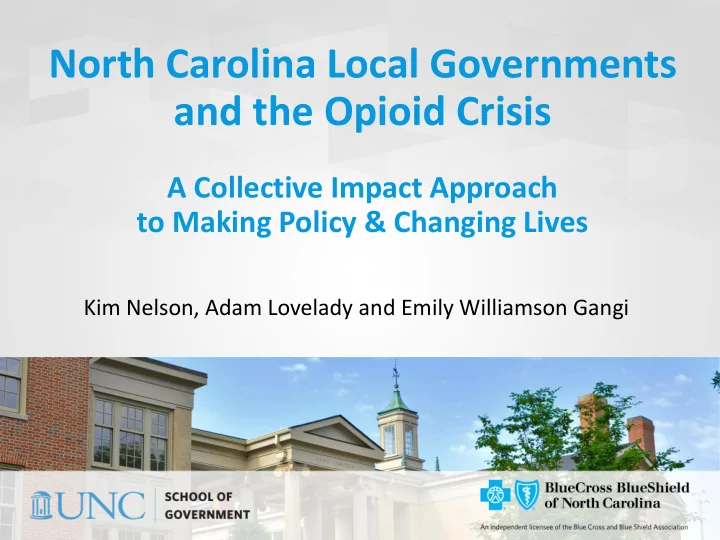

North Carolina Local Governments and the Opioid Crisis A Collective Impact Approach to Making Policy & Changing Lives Kim Nelson, Adam Lovelady and Emily Williamson Gangi
Outline 1. Local Governments and the Opioid Crisis 2. Program Overview 3. Resources and Expectations 4. Application Process 5. Questions
1. . Local Governments and the Opioid Crisis
Opioid Effects on Local Governments • Foster care and social services demands • Law enforcement and emergency management increasing numbers of opioid-related responses • Public health offices resources are strained • Insufficient treatment centers for court-ordered treatment • Mental and emotional toll on local government employees
Examples of Ongoing Efforts • NC Harm Reduction Coalition • Project Lazarus • NC Department of Justice, Opioid Resource Manual • Governing Institute, Confronting a Crisis: A Practical Guide for Policy Makers to Mitigate the Opioid Epidemic • NC Association of County Commissioners “Meeting in a Box”
A New Approach School of Government + Blue Cross NC Using a Collective Impact approach Collaborate with local governments to develop and implement responses to the opioid crisis
2. . Program Overview
Basics of f the Program • Two-year duration • 10 community teams • 5 forums for collaborative learning and problem-solving • Ongoing local efforts with support from the School • School publication to identify community challenges and promising potential solutions • Key objectives: • Help communities identify primary impacts of the opioid crisis • Build on prior work in the community • Formulate programs, plans, policies, and strategies to mitigate identified impacts
How is this program unique? • We seek to achieve collective impact • School will serve as the backbone organization • On-site support through community project managers
3. . Resources and Expectations
The School will provide: • Five regional forums • Faculty support throughout the process • $10,000 to assist with hiring a community project manager • $10,000 in implementation funding • Resources for use in other communities
What does a backbone organization do? • Guide participants’ visions and strategies • Support the aligned activities of team members • Work with teams to establish measurement for goals • Help teams build public goodwill for the project • Assist team members with challenges they may encounter
Parti ticip ipating communit itie ies wil ill l contribute: • A committed team • Travel funds for team members to attend forums • Supplemental funds as needed to implement strategies
Who should be on a team? • Diverse group of organizations represented: • At least one county is required to participate • Can be individual county; multi-county; municipal-county • Other organizations that may be represented: • Non-governmental organizations: churches, anti- addiction organizations, neighborhood groups, etc. • Private sector organizations: drug treatment facilities; major insurance providers, etc.
In Individual l team members may in include: • County/city managers • Public health officials • Key community interest group representatives • Elected officials • Law enforcement officials • Mental health officials • Judges and/or magistrates • School superintendents • Others
More about the teams • Overall size will vary • Each team must identify three core team members • Core team — more substantial commitment • Three key individuals • Represent different organizations • Commit to attending all forums and community meetings
4. . Application Process
The application • Local government(s) on community team • (at least one county) • Community description • Magnitude of opioid crisis in your community • Prior and ongoing efforts • Core team (3 individuals) • Potential members of full team • Three letters of support from relevant leadership • Contact person Online application: https://www.sog.unc.edu/resources/microsites/responding-opioid-crisis
What is selection based on? • Diversity — geographical, economic, demographic • Prior experience with opioid-related mitigation efforts • Magnitude of the crisis in a community • Identification of a core team • Demonstration of commitment through three letters of support
What are the key dates? April 6, 2018 Application window closes May 4, 2018 Selected teams notified June 8, 2018 Team formation complete July 6, 2018 First disbursement of funds to community teams September 12, 2018 First Forum (at School of Government)
5. . Questions
SOG Team Members School of Government ncIMPACT Kimberly Nelson, Associate Anita Brown-Graham, Professor Professor and Director knelson@sog.unc.edu brgraham@sog.unc.edu Adam Lovelady, David Brown, Assistant Professor Research Director adamlovelady@sog.unc.edu brown@sog.unc.edu Jill Moore, Emily Williamson Gangi, Associate Professor Engagement Director moore@sog.unc.edu emily.gangi@unc.edu For questions about the program, please contact Kim Nelson or Emily Williamson Gangi.
Recommend
More recommend